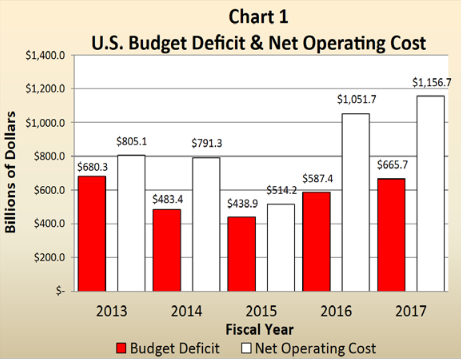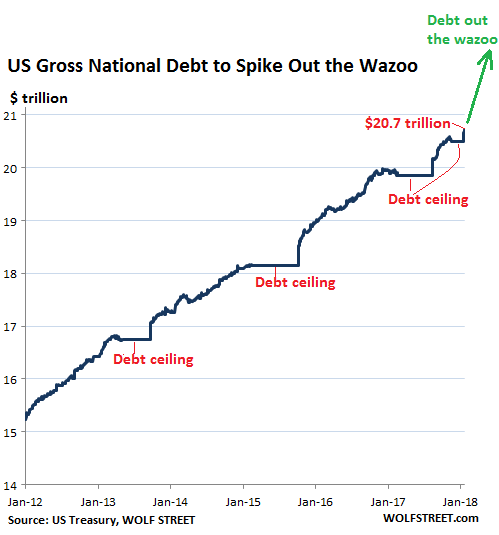Wolf Richter wolfstreet.com, www.amazon.com/author/wolfrichter
Just add tax cuts and ballooning expenditures. The media chose to silence the report to death.
“If a tree fell in a forest and nobody heard it, did it really make a sound?” asks our favorite fiscal gadfly and Director of Research at Truth in Accounting, Bill Bergman, referring to the media coverage that the Treasury Department’s “Fiscal Year 2017 Financial Report of the U.S. Government” has received, which was, at the time he wrote it 24 hours after the February 15 release of the report: “Nothing. Zip. Scratch.”
Friday’s issue of the Wall Street Journal did not say a word about our public purse, or what happened to it last year. In the “What’s News” section on the front page, we learn about compelling things like “Billionaire investor Thiel is relocating to Los Angeles,” “Nestle’s sales growth last year was the slowest in decades,” and “U.S. motor vehicle deaths remained near decade-high levels in 2017.”
But we don’t learn anything about the financial condition of the federal government, from neither the Wall Street Journal nor the New York Times.
The largest financial institution in world history issued its annual report yesterday, and nobody cares.
That’s probably a good thing, given the kind of fiasco it is:
Here’s a summary of the salient data points of the FY 2017 Financial Report of the U.S. Government (full PDF).
- “Net cost” before taxes and other revenues rose by $129 billion year-over-year, or 2.9%, to $4.5 trillion.
- Tax and other revenues grew by $29.3 billion year-over-year, or 0.9%, to $3.4 trillion.
- The difference, the Net Operating Cost or the “bottom line,” as the report calls it, soared 10% year-over-year to $1.157 trillion.
- The Budget Deficit, a different measure, grew by $78.3 billion, or 13.3%, to $665.7 billion.
The Net Operating Cost ($1.157 trillion) is defined as revenues minus costs. The Budget Deficit ($665.7 billion) is defined as receipts minus outlays (cash spent). The difference of $491 billion between the two is, according to the report, “primarily due to accrued costs (incurred but not necessarily paid) related to increases in estimated federal employee and veteran benefits liabilities and certain other liabilities that are included in net operating cost, but not the budget deficit.”
So the Net Operating Cost is a more realistic measure of the actual gap between the government’s revenues and expenditures.
This chart from the report compares the Net Operating Cost and the Budget Deficit over the past five years. Note that the Net Operating Cost and the Budget Deficit increased for the second year in a row:

This is who paid the $3.4 trillion in revenues:
- 80% from Individual income tax and tax withholdings, including Social Security
- 9% from Corporation income taxes
- 11% from other revenue.
And this is how the $4.5 trillion in costs were divvied up:
- 24% Department of Health and Human services
- 22% Social Security
- 15% Department of Defense
- 11% Department of Veterans Affairs
- 22% All other
- 6% Interest on Treasury Securities held by the public
“Where We Are Headed”
That $1.156 trillion in Net Operating Cost occurred in fiscal 2017. But these are the good times, the boom years, if you will, when shortfalls should shrink into oblivion. So what will happen to the shortfall when the economy slows down or goes into a recession? That was a rhetorical question.
For fiscal 2018 and going forward, the tax cuts will lower revenues by about $150 billion per year on average over the next ten years. And for fiscal 2018 and 2019, Congress passed the two-year budget resolution that will add about $150 billion on average per year to the outlays. Both combined will drive up the deficit by about $300 billion a year on average.
“Where We Are Headed” a chapter heading (pages 9 and 14) says. I can supply my own chart, based US Treasury data, to show exactly “where we are headed” in terms of the US gross national debt:

Bill Bergman, at Truth in Accounting, chimes in again with “some takeaways” from the report, namely the government’s persistent inability to provide accurate and auditable financial statements, particularly the Defense Department and the Energy Department (which handles much of the expenditures related to nuclear weapons programs):
The GAO {Government Accountability Office] delivered another disclaimer of opinion on the government-wide financial statements. This was the 20th consecutive year for what is effectively a flunk on your audit. GAO cited material weaknesses in “accounting for intergovernmental activity,” an “ineffective consolidation process,” and “serious financial management problems at the Department of Defense” that prevent the statements from being auditable.
The GAO audit opinion took note of a new department-wide audit initiative at the Department of Defense, mainly reporting on what DoD has said it intends to do, without providing much evaluation or expectations.
The term “material weakness” (in accounting and/or internal controls) appeared 65 times in this year’s report, down from 67 times last year. The total number of cited “material weaknesses” fell from 45 to 40.
This year’s overall report was delivered despite the lack of financial statements from the Department of Energy, a huge department with significant defense-related programs, assets and liabilities, including massive obligations relating to reclamation of nuclear testing waste.
Is the Fed trying to send a message to Congress about all this? The chorus for four rate hikes is getting louder. But no one will be ready for those mortgage rates. Read… Four Rate Hikes in 2018 as US National Debt Will Spike
I say the president Tell congress and the treasury that they are in control of the U.S. monetary system , and the fed is a cancer and we should not have to pay them interest to print our money. and just end paying the FED and the Bankers and when they start making waves arrest them and try them for their crimes.Of which there are many.